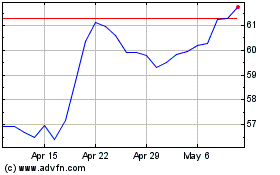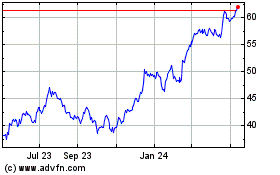Wells Fargo Global Dividend Opportunity Fund Announces Change to Managed Distribution Plan
August 18 2021 - 7:31PM
Business Wire
The Wells Fargo Global Dividend Opportunity Fund (NYSE: EOD), a
closed-end fund, announced today that the fund’s Board of Trustees
has approved a change to the fund’s managed distribution plan.
Effective with the distribution to be declared in August 2021,
the plan will provide for the declaration of quarterly
distributions to common shareholders of the fund at an annual
minimum fixed rate of 9% based on the fund’s average monthly net
asset value (NAV) per share over the prior 12 months. Under the
managed distribution plan, quarterly distributions may be sourced
from income, paid-in capital, and/or capital gains, if any.
Shareholders may elect to reinvest distributions received pursuant
to the managed distribution plan in the fund under the existing
dividend reinvestment plan, which is described in the fund’s
shareholder reports.
The Wells Fargo Global Dividend Opportunity Fund is a closed-end
equity and high-yield bond fund. The fund’s investment objective is
to seek a high level of current income. The fund’s secondary
objective is long-term growth of capital.
Under the managed distribution plan, the fund will distribute
available investment income to its shareholders quarterly. If
sufficient investment income is not available on a quarterly basis,
the fund will distribute long-term capital gains and/or return
capital to its shareholders in order to maintain its managed
distribution level. The fund expects that distributions under the
managed distribution plan may exceed investment income.
Distributions in excess of net investment income will be treated as
distributions of capital gains to the extent of realized gains
during the fiscal year. Any distributions in excess of both net
investment income and realized gains will be treated as returns of
capital. No conclusions should be drawn about the fund’s investment
performance from the amount of the fund’s distributions or from the
terms of the fund’s managed distribution plan.
The amount distributed per share is subject to change at the
discretion of the fund’s Board of Trustees. The managed
distribution plan will be subject to periodic review by the fund’s
Board of Trustees to determine whether the managed distribution
plan should be continued, modified, or terminated. The fund’s Board
of Trustees may amend the terms of the managed distribution plan or
suspend or terminate the managed distribution plan at any time
without prior notice to the fund’s shareholders. The amendment or
termination of the managed distribution plan could have an adverse
effect on the market price of the fund's shares.
With each distribution that does not consist solely of net
investment income, the fund will issue a notice to shareholders
that will provide detailed information regarding the amount and
composition of the distribution and other related information. The
amounts and sources of distributions reported in the notice are
only estimates and are not being provided for tax reporting
purposes. The actual amounts and sources of the amounts for tax
reporting purposes will depend upon the fund’s investment
experience during its full fiscal year and may be subject to
changes. The fund will send shareholders a Form 1099-DIV for the
calendar year that will tell shareholders how to report these
distributions for federal income tax purposes.
For more information on Wells Fargo’s closed-end funds, please
visit our website.
This closed-end fund is no longer available as an initial public
offering and is only offered through broker-dealers on the
secondary market. A closed-end fund is not required to buy its
shares back from investors upon request. Shares of the fund may
trade at either a premium or discount relative to the fund’s net
asset value, and there can be no assurance that any discount will
decrease. The values of, and/or the income generated by, securities
held by the fund may decline due to general market conditions or
other factors, including those directly involving the issuers of
such securities. Equity securities fluctuate in value in response
to factors specific to the issuer of the security. Small- and
mid-cap securities may be subject to special risks associated with
narrower product lines and limited financial resources compared
with their large-cap counterparts and, as a result, small- and
mid-cap securities may decline significantly in market downturns
and may be more volatile than those of larger companies due to
their higher risk of failure. Debt securities are subject to credit
risk and interest rate risk, and high-yield securities and unrated
securities of similar credit quality have a much greater risk of
default and their values tend to be more volatile than higher-rated
securities with similar maturities. Foreign investments may contain
more risk due to the inherent risks associated with changing
political climates, foreign market instability, and foreign
currency fluctuations. Risks of foreign investing are magnified in
emerging or developing markets. Derivatives involve risks,
including interest rate risk, credit risk, the risk of improper
valuation, and the risk of noncorrelation to the relevant
instruments they are designed to hedge or closely track. There are
numerous risks associated with transactions in options on
securities and/or indexes. As a writer of an index call option, the
fund forgoes the opportunity to profit from increases in the values
of securities held by the fund. However, the fund has retained the
risk of loss (net of premiums received) should the price of the
fund’s portfolio securities decline. Similar risks are involved
with writing call options or secured put options on individual
securities and/or indexes held in the fund’s portfolio. This
combination of potentially limited appreciation and potentially
unlimited depreciation over time may lead to a decline in the net
asset value of the fund. The fund is leveraged through a revolving
credit facility and also may incur leverage by issuing preferred
shares in the future. The use of leverage results in certain risks,
including, among others, the likelihood of greater volatility of
the net asset value and the market value of common shares.
Wells Fargo Asset Management (WFAM) is the trade name for
certain investment advisory/management firms owned by Wells Fargo
& Company. These firms include but are not limited to Wells
Capital Management, LLC, and Wells Fargo Funds Management, LLC.
Certain products managed by WFAM entities are distributed by Wells
Fargo Funds Distributor, LLC (a broker-dealer and Member
FINRA).
Wells Fargo Asset Management does not provide accounting, legal,
or tax advice or investment recommendations.
This material is for general informational and educational
purposes only and is NOT intended to provide investment advice or a
recommendation of any kind—including a recommendation for any
specific investment, strategy, or plan.
Some of the information contained herein may include
forward-looking statements about the expected investment activities
of the funds. These statements provide no assurance as to the
funds’ actual investment activities or results. Readers must make
their own assessment of the information contained herein and
consider such other factors as they may deem relevant to their
individual circumstances.
PAR-0821-00541
INVESTMENT PRODUCTS: NOT FDIC INSURED ● NO
BANK GUARANTEE ● MAY LOSE VALUE
WF-CF
View source
version on businesswire.com: https://www.businesswire.com/news/home/20210818005847/en/
Media Jeanette Foster, 415-264-1323
jeanette.d.foster@wellsfargo.com
Shareholder inquiries 1-800-730-6001
Financial advisor inquiries 1-888-877-9275
Wells Fargo (NYSE:WFC)
Historical Stock Chart
From Mar 2024 to Apr 2024

Wells Fargo (NYSE:WFC)
Historical Stock Chart
From Apr 2023 to Apr 2024
